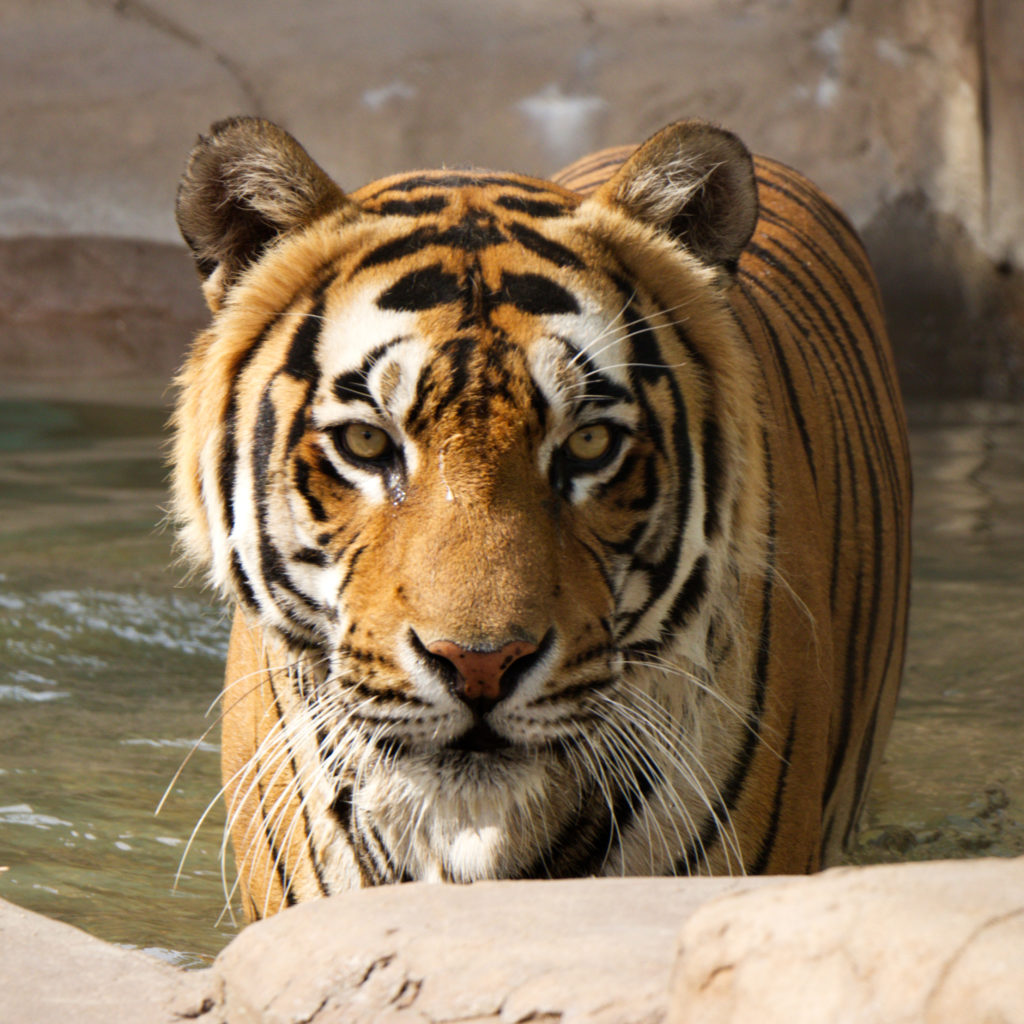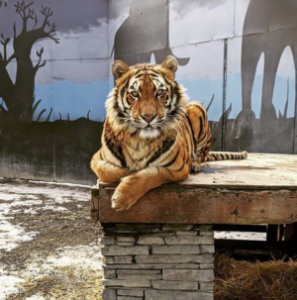Many captive born wild and exotic animals are still used through out the United States as props in pictures with paying guests. There is a difference between a “photo-op” and an Ambassador Animal that is part of an educational program where the animal is carefully supervised and it’s health and welfare are the priority. A question to ask is “what happens to that animal once it is no longer small, cute, profitable, or becomes ill, dangerous, and/or illegal?” Under current USDA regulations (2021) big cats such as lions and tigers, can only have exposure to public physical contact until 12 weeks of age. This is the most vulnerable age for these animals. Many are stressed or become ill from being mishandled or exposure to disease. We know that some are sold to responsible private individuals, but the majority that survive eventually end up at rescue sanctuaries like Cat Tales.
Bengal Tiger – Panthera tigris tigris
Habitat: Grasslands and rainforest of India, Bangladesh, and Nepal
Lifespan: Wild 12-15 years; Captivity 18-20 years
Diet: Carnivore
Status: Endangered
The tiger is the largest member of the cat family, and its orange coat with black stripes and white markings is instantly recognizable. Its size, coat color and markings vary according to subspecies. Although 8 subspecies are recognized historically, 3 have become extinct since the 1950s. And out of the 5 remaining, 3 are critically endangered.
The tiger’s habitat varies widely, from the tropical forests of Southeast Asia to the coniferous woodlands of Siberia, but is basic requirements are dense cover, access to water, and sufficient large prey. Hunting mainly be night, it takes mostly deer and wild pigs, and cattle in some regions, but it also eats smaller animals, including monkeys, birds, reptiles, and fish, and readily feeds on carrion. Tigers will also attack young rhinoceroses and elephants. They may eat up to 88 pounds (40 kg) of meat at a time and return to a large kill for 3-6 days. Tigers are usually solitary but are not necessarily antisocial. A male is occasionally seen resting or feeding with a female and cubs, and tigers may also travel in groups.
A young tiger is dependent on its mother for food for the first year or so of life. By the time it is 2 years old, it will have enough power, strength, and experience to be able to catch prey for itself. It may start breeding in its fourth or fifth year and live on average to the age of 8-10.
The Bengal tiger, Panthera tigris tigris, the most common of the subspecies, exhibits the classic tiger coat, deep orange with white undersides, cheeks, and eye areas, and distinctive black markings. Tigers have long sensitive whiskers and sharp retractable claws. Tiger stripes, which range from brown to jet-black, vary in number, width, and tendency to split. No 2 tigers have the same markings.
The surviving subspecies of tiger differ markedly from one another. In general, animals from northern regions are a paler orange and have fewer stripes. They also have much longer and thicker coat in winter to protect them from the cold. The Siberian tiger, Panthera tigris altaica, is the largest subspecies, and the lightest in color, with the longest coat. Its numbers may be as low as 150-200. The smallest and darkest of the tiger subspecies is the Sumatran tiger, Panthera tigris sumatrae. Only about 600 are though to exist today.
Between 1900 and 2000, tiger numbers fell from an estimated 100,000 to 3,500 – approximately the figure today. After decades of poaching, habitat loss, and loss of prey, scattered populations survive only in eastern Russia, China, Sumatra, and in southern Asia from Vietnam to India. Although protected in most areas, tigers are still killed to meet the demand for bones and body parts, which are used in oriental medicines. Programs to save the tigers have met with mixed results, with limited successes set against the trend of overall decline. Radio collars and antipoaching patrols give these vulnerable predators at least some protection in the wild.
Meet Our Bengal Tigers


Tigger and Zorro
Tigger came to us with his brother Zorro and our lioness Nala**. The three were photo opportunity cubs in a county fair in the state of Oregon. In 2010 Cat Tales received a call that someone wanted to donate two Bengal tiger cubs. When Cat Tales’ staff arrived and started to transport the boys, Nala let our keepers know that she was coming, too. So, two became three, but, once these cats reached maturity, there were all moved into sperate enclosures. Tigers are solitary species and do not typically live together as adults, especially two unneutered males. Lions are social, but a female lioness housed with male tigers is likely to result in tigons, a manmade species. Born May 20, 2010
**Nala passed away in August 2022 due to an advanced uterine infection. We miss her dearly!


